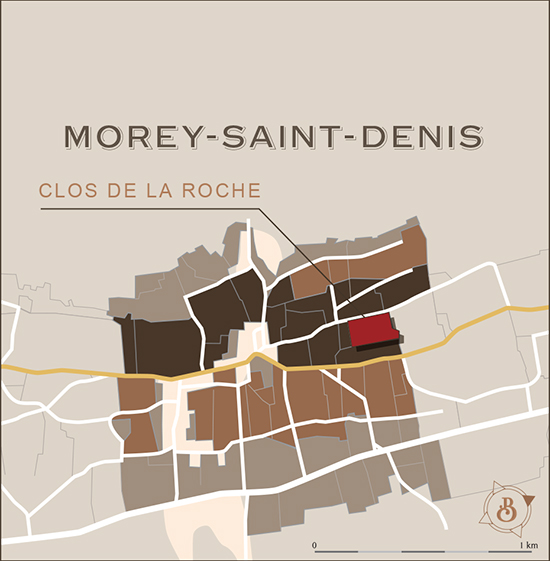Clos de la Roche
Grand Cru 2017
This wine’s name alone makes one almost forget that it hails from one of the most famous Grand Cru villages: Morey-Saint-Denis.
Origin
Nestled between Gevrey-Chambertin and Chambolle-Musigny, Morey-Saint-Denis produces five Grands Crus.
Located at the north of the commune, Clos de la Roche takes its name from a boulder that the Celts used for their rituals. Lying adjacent to the Latricières-Chambertin vineyard, it produces Morey’s most robust wines. This vineyard is difficult to work, with such stony soil that was considered to be a “backbreaker” by the growers of yesteryear. This hard, brown limestone soil yields very firm wines that are well-suited to ageing.
Viticulture
Grape variety: pinot noir
Soils: very limestone, some scree and shallow earth.
Orientation: East
Surface area under vine: 0.1705 ha
Pruning: Guyot system
Yield: 42 hL/ha
Average age of the vines: 50 years old.
Vinification
Harvest date: 16 September 2017.
The grapes were handpicked. They were sorted a first time in the vineyard and again on the sorting table when they arrived at the winery.
At the winery: The grapes were 50% destemmed and were gravity-fed into tanks. Maceration lasted a total of 21 days including 4 days of cold maceration (12°C). Fermentation used indigenous yeasts only (no additives such as enzymes or tannins were used). 4 punchings of the cap.
Ageing
Maturation: aged on the lees for 16 months with no racking using a proportion of 100% new French oak barrels.
Barrels: French oak barrels that had been toasted at low temperatures for a long time to impart a very delicate touch of oak to the wine.
Bottling
Bottling: The wine was bentonite fined and very gently filtered before being bottled using gravity in March 2019.
Number of bottles: 840 & 60 magnums.
Vintage
2017, finesse
The growing cycle was thrown off-kilter by a very cold winter, late spring frost, then optimal conditions for rapid flowering, sporadic hail, and summer drought. Harvesting began in early September in the sun, and after several lean years, the vines finally produced abundant grapes, although with significant differences in maturity between whites and reds and from one region to another, which called for strict sorting.
Ageing potential: 10 years and more.
Tasting notes
With its beautiful shiny ruby color, this Grand Cru exudes intense aromas of violets, its signature !. There are also aromas of red berries and smoky notes. The palate, this dense and gourmet wine, reveals a good length thanks to very fine tannins.



